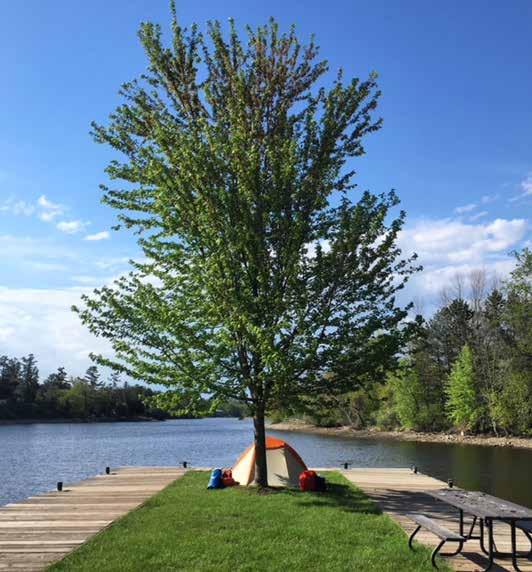
4 minute read
CANOEING Exploring the Rideau Canal in reflective mode
BY JASON MYERSON
Hard paddle brings perspective
Advertisement
WHEN YOU’RE motivated to explore outside your comfort zone, doubt can come quickly. Parents worry friends fret, and even your own research can make you reconsider your plans.
But if you are in pursuit of a different perspective on life, the Rideau Canal waterway is the perfect pitch-off point.
We planned to paddle the waterway in its entirety, to seek a life perspective from rivers, not roads, amid the beauty of eastern Ontario. So, on May 19 Laura Rose Swan and I launched our 10-foot canoe (The Mosquito) from Kingston for a journey along the historic main route. With little paddling experience, we planned to canoe 40 kilometres a day for five days with minimal gear, navigating rivers, lakes, and portaging the 23 lock stations while camping along the way.
The 202 kilometres of rivers, lakes and man-made canal between Kingston and Ottawa was built to defend us from further invasion from the United States after 1812-1814. Yet, underneath is a more ancient intrusion, a continental collision that formed the Grenville mountain range a billion years ago. The remnants are now a geologist’s nerd-out, and an elevation gain of 50 metres from Lake Ontario to its summit of Upper Rideau Lake. Today the Rideau waterway is the oldest continuously operated canal in North America and all levels of paddlers can enjoy its adventure.
We launched into swollen waters with headwind gusts of 30 km/h northeast and waves high enough to splash over the bow. Laura kept the bow straight to the waves, while I bailed lake water out of the canoe. We learned quickly to navigate, work together under stress, and communicate effectively. Light rain mingled with our sweat. We had heard that the weather on the water can change fast, and sure enough, soon after, the winds calmed.
The white tips of the waves exchanged visuals with a flock of white swans canoodling in the distance as huge carp washed over each other in spawn. Loon couples popped up out of nowhere and mysteriously kept us in their sight.
The pressure of isometric exercise makes bones stronger, and immense earth pressure makes carbon into diamonds, so perhaps, we thought, challenges like this could produce fortitude of character. Nine hours of paddling a day was a physical test that compressed our spirits to humility before elevating them at the end of the day as we took in our environment. We felt small but not helpless, realizing that even though we couldn’t master nature, we could become a part of it.
Our bodies ached by the third day, but we became comfortable with our discomfort. We laughed into the serene silence as the day breezed by and our emotional barometers maxed out. Note, being slack-jawed by awe on the water requires chapstick with a good SPF. By now we could attend to the immediate, or shift easily to the existential.
Each morning we would take our time with coffee by the shore. The small sachets of instant coffee gave us a black powder pioneer feel as we tore them with our teeth. And we reflected on those who had lost their lives building the canal and colonizing the country.
When we arrived at a lock station to set up camp each night, friendly Parks Canada employees working to beautify their post greeted us. They asked how we managed so far, told us what to expect up ahead, and with a chuckle asked us to mention at the next station how attractive theirs had looked. At a practical level, all stations have bathrooms, drinking water, and an outlet to charge batteries. We would pitch the tent, lock up the canoe, and basically inhale our dinner before collapsing into a stone-like slumber. Fires are banned at the lock stations, so our warm sweaters and dry sleeping bags were essential.
There were a few people around, kind, capable, and happy to chat.

Animals were never an issue, but we hung our food in a nearby tree anyway. Our waterproof map was easy to read – wading in the water looking at it as we snacked on chocolate and trail mix. I think the only item we would bring next time in addition to our neoprene gloves, would be a pair of neoprene shoes to keep our toes warm even when wet.
The next time we paddle the canal we’ll double the time to explore along the way, stopping in the small towns, museums, old stone mills, and the artisan shops along the way.
After reaching home in Ottawa, people would ask us where we were going to go next. All we could think of was, further.











